The Minolta W.Rokkor MD 24mm f2.8 has a reputation of being one of the sharpest 24mm lenses ever made. Even Leica licensed it for their R mount, and by that giving it credence as an excellent construction.
So how does it hold up today against modern lenses and digital media?
Since I just got hold of it in a near to mint condition (for a more than reasonable price) and I also own a Sony Zeiss 16-35mm f4 zoom (known for it sharpness at 24mm) I thought a shootout would be a fun idea.
An almost 40 years old $200 prime agains a modern $1200 zoom. How would that end?
Doing the shootout
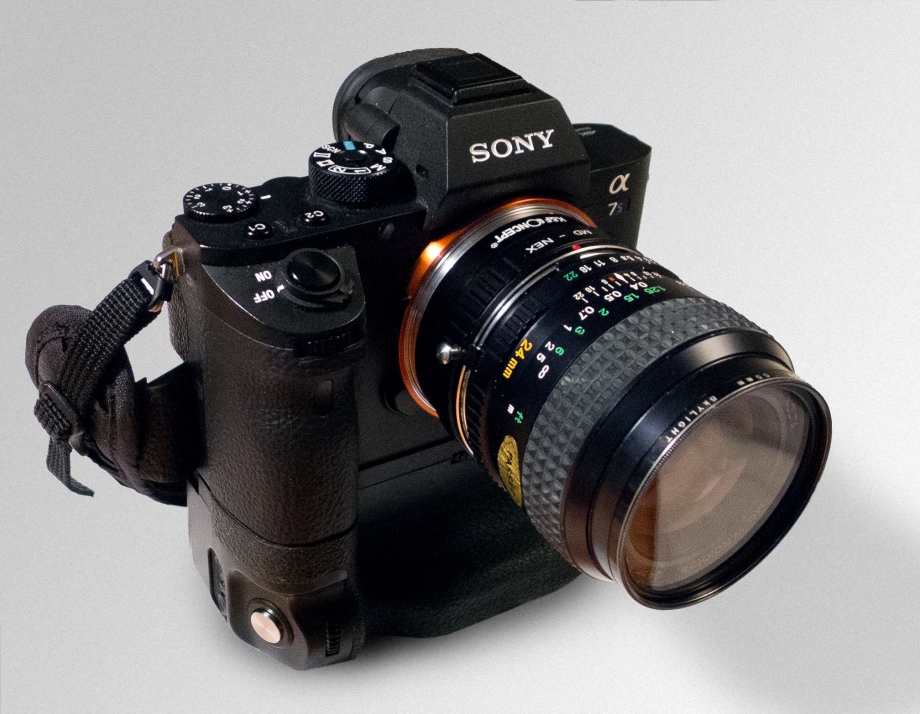
Dealing with it in a sort of semi-unscientific way I set up my tripod in the kitchen and took pictures of the eastern wall with both lenses at different apertures, all in raw format. I used timer release and silent shutter to remove as much vibration as possible and set the focus at the largest aperture in the center of the image.
The raw images where converted to JPEG in Photoshop without any additional processing, sharpening or lens correction except for a small adjustment for exposure (the same for all images).
Images
Here are all the images. You can click on them to see them in full resolution but crops are included further downing in the post for those of you who are not prepared to jump in at the deep end.
f2.8
f4
f5.6
f8
f11
f16
Crops
Here follows 100% crops from both lenses for all the apertures I’ve tested with my initial comments and reflections. Feel free to add your additional comments or thoughts in this post’s comments.
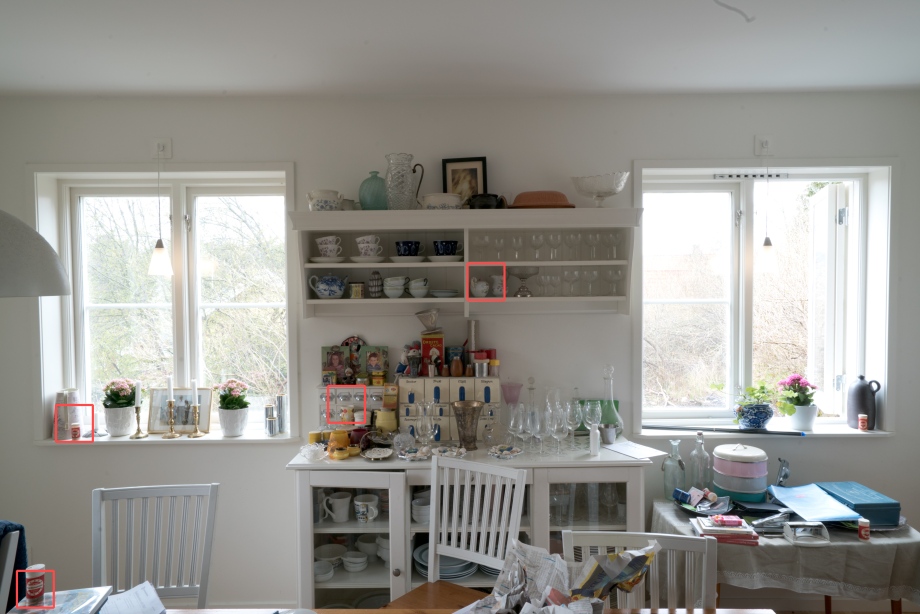
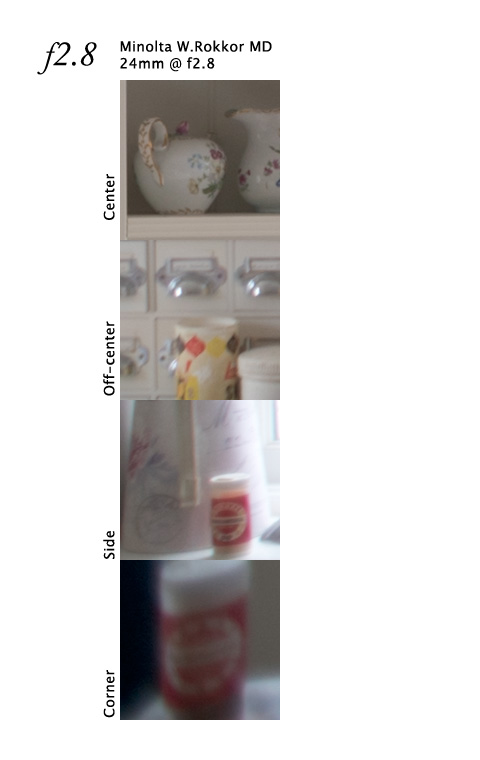
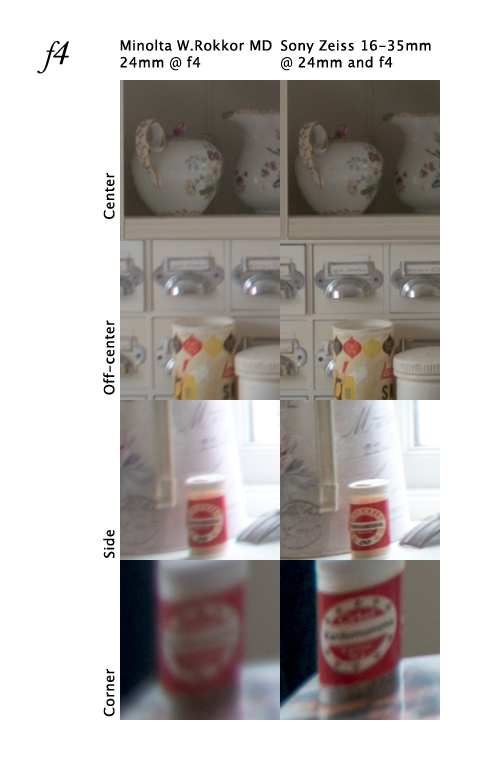

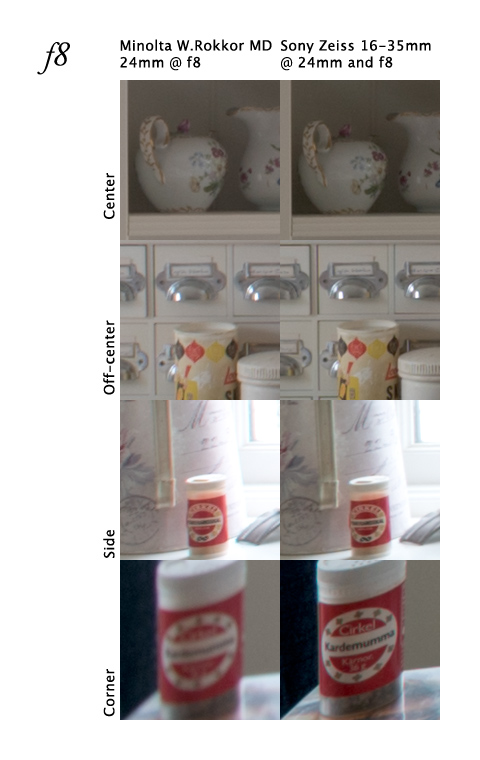
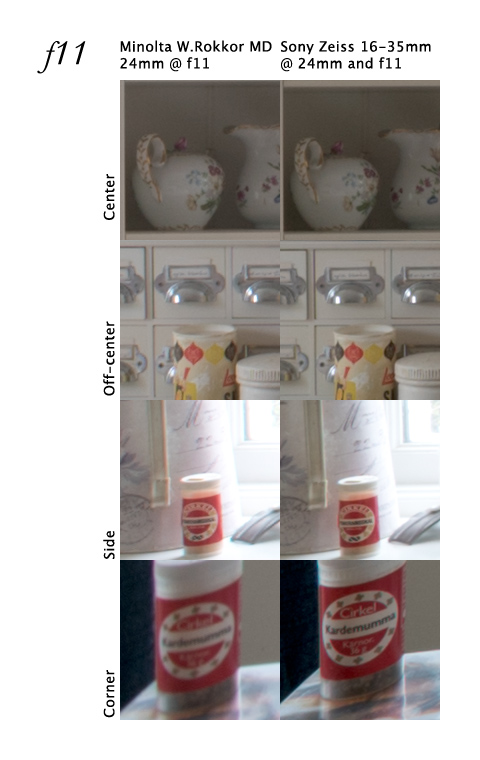
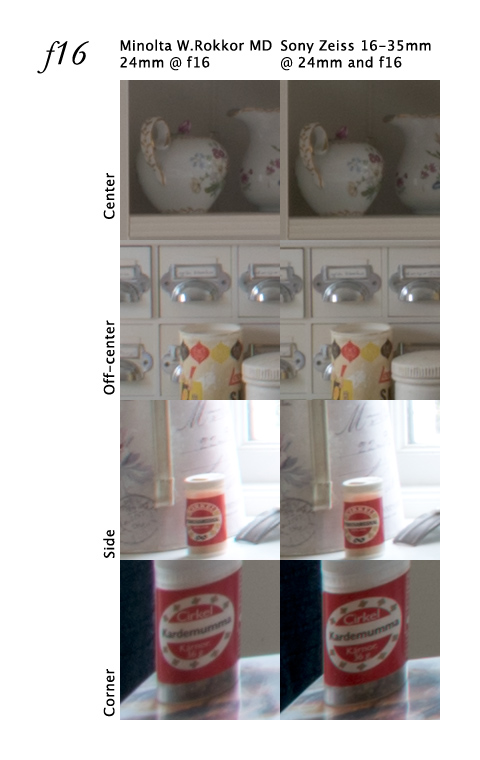
Conclusion
There is no doubt, in this shootout the Sony Zeiss beats the Rokkor on every point except one. It’s sharper overall and especially in the off-center and in the corners. It has better contrast, less aberrations and less vignetting. Only in the color rendering I find the Rokker more even and pleasing. The Sony Zeiss tend to be a bit uneven with a warm center and colder corners.
Does this mean that the Rokkor is a bad lens all over? Probably not. First it means that the Sony Zeiss zoom is a very good lens. Second, as long as you stop down the Rokkor to at least f4 or f5.6 you get better to excellent results. From there on it’s almost as sharp as the Sony Zeiss except for the extreme corners.
I also like the colors of the Rokkor better than the Sony Zeiss.
Aberrations and vignetting are worse on the Rokkor but within reasonable limits and if you shooting digital these are easily fixed in post.
One advantage of the Rokkor is also the size and weight compared to the Sony Zeiss. Though not as large as other modern super wide-angle zooms, it’s still a considerable bulkier and heavier lens.
For $1200 you would expect the Sony Zeiss to perform the way it did. For $200 the performance of the Rokkor stopped down to 5.6 or more leaves very little to complain about. A good budget alternativ as long you don’t need those larger apertures or use it’s weaknesses to your advantage.
Update
I did some further investigation into the unexpected low border and corner sharpness of the Rokkor at larger apertures. It seems that at least some of it is due to field curvature at the actual distance I used. Focusing at the corner makes them much more sharp than in my test but then the center becomes unsharp instead. I estimated to just under a meter in difference which is quite much on this short distance.
Normally not really a real world problem since we seldom take pictures of flat walls all the way to the corners. Still it’s always good to know your lenses.
Could be I’ve got a bad sample too.
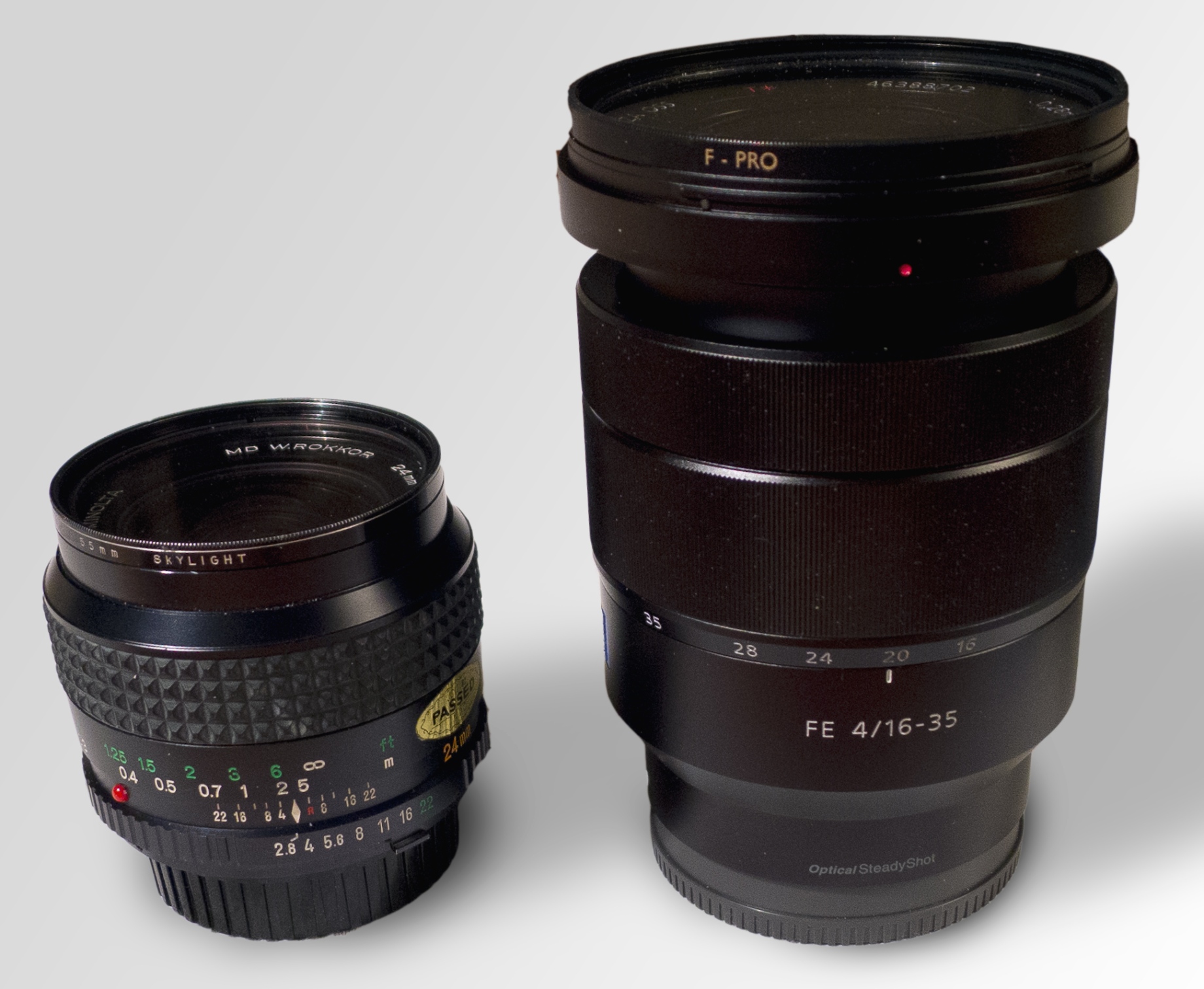












Olympus om 24mm 2.8 is the probably the best affordable lens in 24mm focal length used on the a7x. Ive tested it against my Minolta 24mm, Nikkor 24mm and Canon fd 24mm. The Olympus and FD 24mm would be good alternative too.
LikeLike
What are your thoughts of the Nikkor compared to the Minolta? Wondering because I have an opening for getting one.
LikeLike
Not bad considering there was no computers to pre-calculate these lens designs back then( i don’t think many manufacturers had any CAD-CAM capability in 1978)
LikeLike
Actually, Minolta started using in-house computers for lens design in the late 60’s for lenses like the 21mm f2.8 !
Not CAD-CAM, that’s manufacturing, but calculation of lenses and their combinations. If you think of it, the flight to the moon was made possible by computers too…
But the Olympus 24mm is a great lens for that focal length.
LikeLike
Fundamentally a flawed test.
Take it down.
You didn’t take field curvature into account, which should have been reason enough to take down the whole thing and redo it.
Film, as the Rokkor lens it made for, also is much better at detecting light at oblique angles.
An electronic sensor has a whole host of crap in front of the sensor sites, which in themselves are at the bottom of a well.
That means that all “digital” lenses has to have strong retro focus build in, something the Rokkor does not have.
That alone will account for everything being unsharp except the center.
LikeLike
Well, and if you would have read to the end I actually mention this shortcoming in the update.
And yes, I agree with the problems regarding field curvature. Still this shows how this lens would perform on a modern sensor.
On the issue of oblique angles. This lens has strong retro focus built into the design since it’s originally made for Minolta SLRs with long flares to accommodate for he mirror. I doubt this is the main problem. If it was the problem there would probably been colors shifts too.
And as far as I know modern sensors can use wide angles with more symmetric designs and shorter flanges. One example is the Loxia 2.8/21. But they have to be designed for the thicker sensor stacks.
LikeLike
I did read your addendum, and used that as a springboard whiles I was worked up. 😉
There is really only so many ways to focus light
Either you hit the sensor sites bang on with light or you don’t.
Getting closer to the sensor by a few millimeters doesn’t matter in that equation.
Even with modern sensors that are shallower in profile, it’s still a problem (and one of the reasons why huge hype around mirrorless is pretty stupid)
On film camera lenses with retro focus you can still have quite oblique angels of incidence, as it makes the optical design less complex and isn’t much of a problem with film.
One of the drawbacks though, is a “differently” shaped plane of focus.
LikeLike
[…] Full list of todays Gold Box deals at Amazon.de, Amazon.co.uk, Bhphoto, eBay and Amazon.com. Sony Alpha 7 Aktion: Bis zu 80 EUR Rabatt auf ausgewählte Objektive at Amazon.de Rokinon 14mm f2.8 review at Ilovehatephoto. EVF: composing vs reviewing (SonyAlphaForum). Sony α6300 – AF Performance Test $2000 class DSLR VS a6300 https://www.youtube.com/watch?v=D5Lja5dcjf4 a7sii comparison johnhicksfilm on Youtube. Firmware update for NEW FDR-AX53 handycam – HUGE improvement in AF (Sony eusupport). Simple shootout between legacy Minolta Rokkor MD 24mm f2.8 and. Sony 16-35mm on Sony Alpha 7S M2 (Scatteredlightblog). […]
LikeLike
There is also the (rare) Minolta 24mm VFC, which has variable field curvature (hence the name), and it can adapt to different shooting situations much better.
LikeLike
I see that you use a K&F adapter. Those are usually quite a bit short which would explain the field curvature you witnessed to some degree because the Minolta is a floating elements design. Here is a fix: https://phillipreeve.net/blog/tuning-adapters-infinity-focus-reflections/
LikeLike
Thanks for the info Phillip. At that time I didn’t have that knowledge. Today I would have known better. But the lens is sold since long.
And regarding the K&F adapters. I have a few for the c/y mount, and yes, they are a fair bit short, focusing past infinity. But I have no floating focus Contax lenses to my knowledge. If I ever get the 28/2.0 or 35/1.4 I’ll try and shim the adapter.
LikeLike